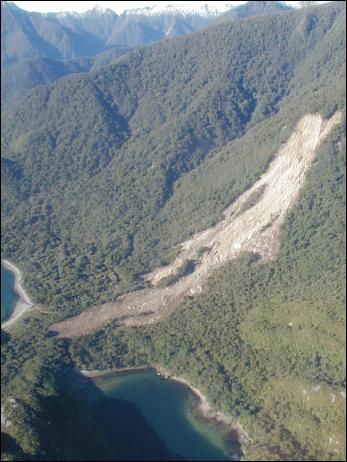Fiordland Quake Triggers Over 200 Landslides
Fiordland Quake Triggers Over 200 Landslides
Last Friday's magnitude 7.1 earthquake in Fiordland triggered more than 200 landslides in Fiordland National Park, geologists said today. " It's inevitable that an impressively big shake and steep country will combine to produce landsliding on a large scale," said geologist Ian Turnbull of the Institute of Geological and Nuclear Sciences Ltd (GNS).

GNS geologists have flown over about 70 percent of central and western Fiordland since Friday, mapping the effects of the earthquake.
It is possible the landslide tally may go over 220 as there are several valleys they have yet to see.
Most of the landslides occurred on slopes of 60 degrees or greater. The most northerly landslides found so far occurred on the Milford Track, 50km northeast of the epicentre at Secretary Island, at the entrance to Doubtful Sound.

The most southerly landslide was at Breaksea Sound about 25km south of the epicentre. A landslide at the head of Lake Te Anau, about 65km from the epicentre, is the most distant landslide from the epicentre yet seen.
The geologists recorded at least seven major summit-to-valley floor landslides covering vertical distances of up to 1500m. They saw large numbers of trees and vegetation floating in the fiords, particularly Doubtful Sound, making a hazard for boating. There was also minor damage right around the shore of Lake Te Anau.
Landslides were a natural landscape-forming process that had been occurring in Fiordland for millions of years, Dr Turnbull said.
>From a geological point of view, there was still a great deal of useful information to be gleaned from the main shock, the after-shocks, and the landslides.
Geologists could use the information gathered in Fiordland to help them calculate which valleys, rivers, and roads in the South Island had a high probability of being blocked by landslides when the Alpine Fault next ruptures.
The Alpine Fault runs almost the length of the South Island between Milford Sound and Marlborough. It ruptures every 250 to 300 years, producing an earthquake of about magnitude 8. It last ruptured in 1717.
GNS seismologist Warwick Smith is scheduled to speak about the Fiordland earthquake at a public meeting in Te Anau on Thursday evening. The Earthquake Commission's insurance manager, Lance Dixon, will also attend the meeting. The Southland District Council has organised the meeting in response to requests from the public for information on the Fiordland quake and earthquakes in general.
According to
the US Geological Survey website, the Fiordland quake ranks
as the fifth equal biggest earthquake in the world this
year


 NIWA: Students Representing New Zealand At The ‘Olympics Of Science Fairs’ Forging Pathway For International Recognition
NIWA: Students Representing New Zealand At The ‘Olympics Of Science Fairs’ Forging Pathway For International Recognition Coalition to End Big Dairy: Activists Protest NZ National Dairy Industry Awards Again
Coalition to End Big Dairy: Activists Protest NZ National Dairy Industry Awards Again Infoblox: Dancing With Scammers - The Telegram Tango Investigation
Infoblox: Dancing With Scammers - The Telegram Tango Investigation Consumer NZ: This Mother’s Day, Give The Gift Of Scam Protection And Digital Confidence
Consumer NZ: This Mother’s Day, Give The Gift Of Scam Protection And Digital Confidence NZ Airports Association: Airlines And Airports Back Visa Simplification
NZ Airports Association: Airlines And Airports Back Visa Simplification Netsafe: Statement From Netsafe About Proposed Social Media Ban
Netsafe: Statement From Netsafe About Proposed Social Media Ban